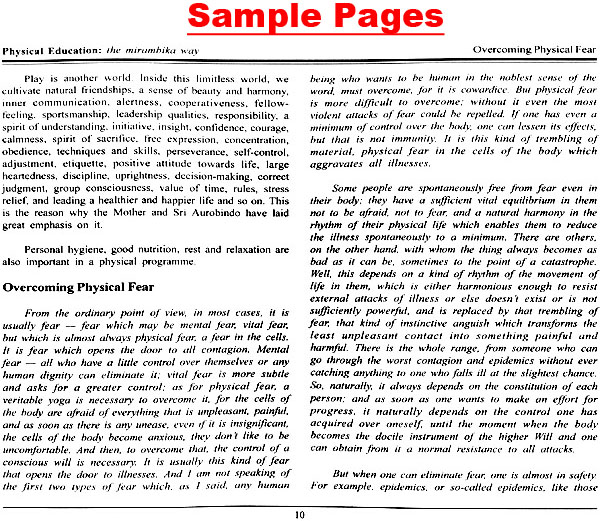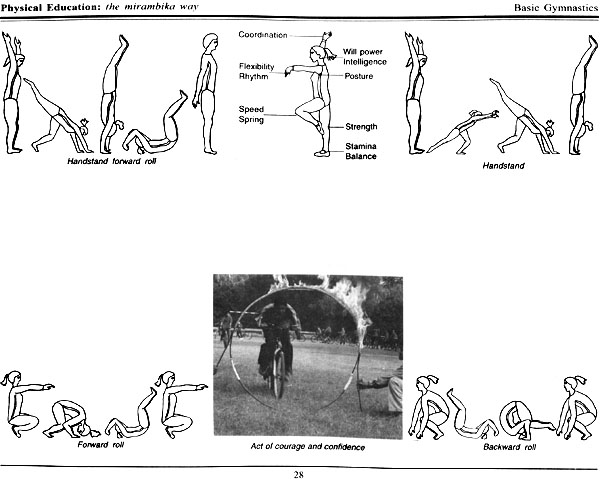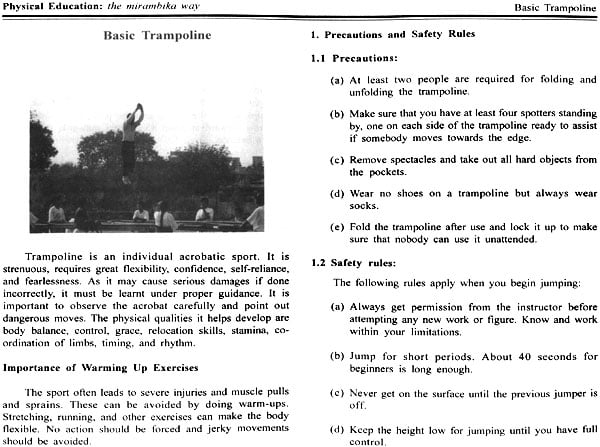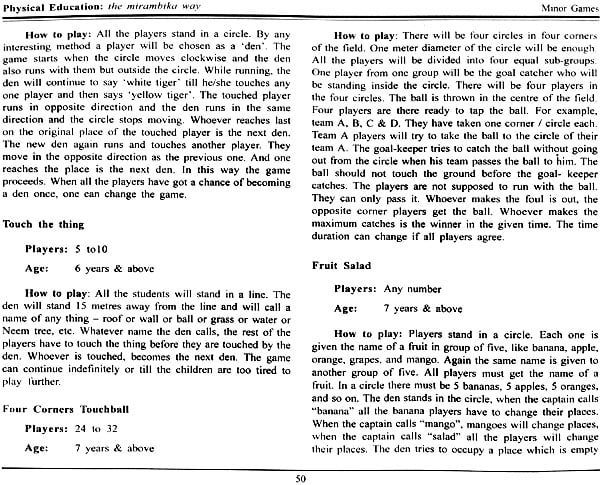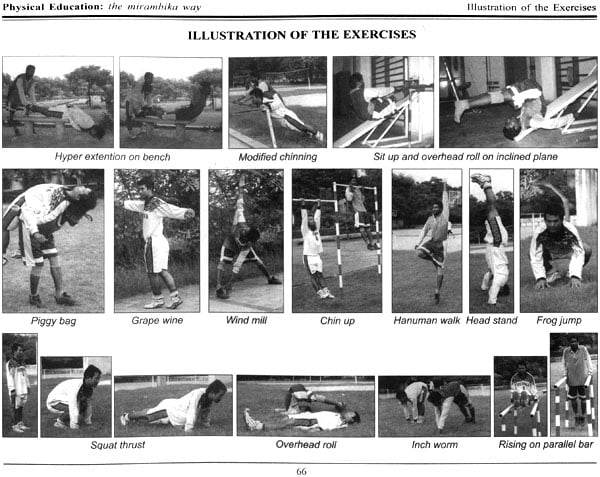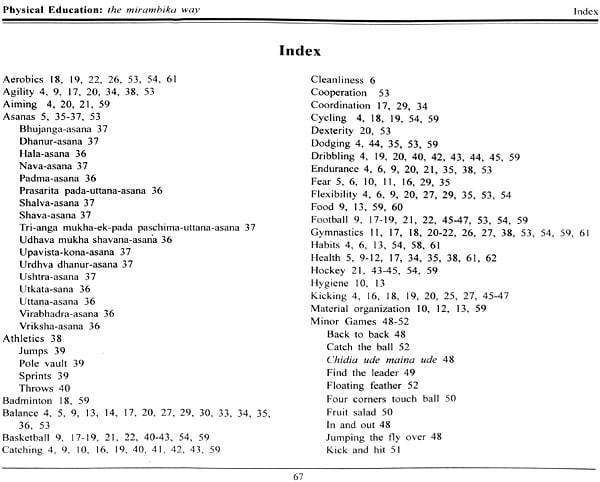
Physical Education (The Mirambika Way)
Book Specification
| Item Code: | NAM570 |
| Publisher: | Sri Aurobindo Ashram |
| Language: | English |
| Edition: | 2004 |
| ISBN: | 8188847054 |
| Pages: | 70 (Throughout B/W Illustrations) |
| Cover: | Paperback |
| Other Details | 8.5 inch X 11.0 inch |
| Weight | 220 gm |
Book Description
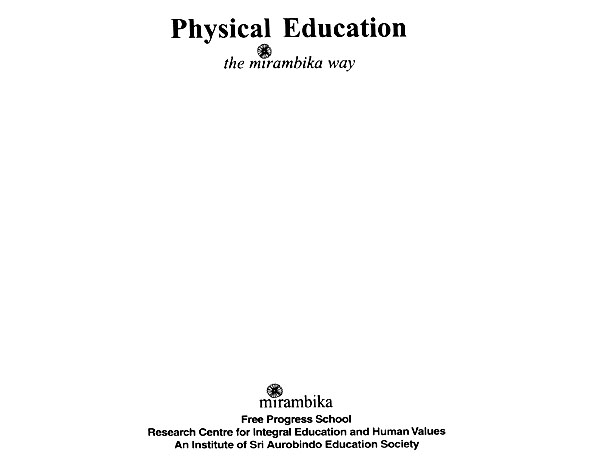
About the Book
Physical Education has perhaps been the most neglected segment of the resent education system. With the ever increasing pressure on today's child to excel academically, it is this field that has been losing its legitimate place in child education. What remains is a mere formality.
Shareeram Adyam Khalu Dharma Sadhanam: agrees Sri Aurobindo. A healthy mind is not possible in an unhealthy body. And what goes to make the body healthy?
This is what the book tries to answer. The answers are innovative and spontaneous, yet very simple. The activities documented in this book arrest the child's imagination and also give it a free play. They include fun games, minor games and major games, organised or otherwise, age-specific games and help in physical, emotional as well as cerebral growth. It initiates, guides long the way and encourages to conceive and add.
In this field of education there is no 'teacher' and 'taught'. Everyone is a learner. Everyone grows, each moment in these activities.
A painstaking (yet pleasurable) and pioneering effort of Mirambika, this book would be of immense help to parents, teachers, educationists and enthusiasts/ researchers in the field of Physical Education.
Introduction
The Need for a Physical Culture
Physical culture is meant to develop the perfection of the body using all means at our disposal. In order to develop the physical consciousness, the awareness of the strengths and limits of the body and its control by the mind is crucial. How does this development occur? Health, strength and fitness are the foundations on which this consciousness rests. The physical body must sense the perfection it can achieve, a state which today we may not even be able to conceive. Simple control of breathing, asanas which help prepare the mind and body are necessary to make it fit for the reception of the energy, which we need to impart greater strength. The victory is gained when the endless striving to overcome fatigue, pain and fear is transformed into an ability to achieve greater power, do impossible feats and manage difficult body postures with ease and conviction.
It is this quest for the greater perfection that the body seeks and the purpose of physical activities is to make it possible. Even before birth, the thoughts and work of the mother act upon the yet unborn child and builds up the effort which later blossoms forth. Even as the child explores the surroundings after birth, cries, kicks, rolls and walks, the physical development grows in leaps and bounds. There are activities which are taught and trained by the mind which go on acting automatically but faultlessly even when not attended to by the thought or will. As the body grows in consciousness, its potentialities increase. The body no longer limits its strength, rather it becomes receptive towards the subtle forces of the universe and this stirs it into greater activities. Hence in order to bring the change to achieve the aim of the supreme perfection of the body, it is necessary to become aware of the body consciousness and awaken in oneself the ability to enable the body to function on its own intuitive movements. As the child grows, the influences of the world around make his/her mind and vital overrule the body consciousness and the natural balance is afflicted.
Bringing back the balance is possible if physical education is practiced with a sound and strong character. The three principles are:
1. Control and discipline of the functioning of the body.
2. A total and methodical and harmonious development of all the parts and movements of the body.
3. Rectification of defects and deformities. - The Mother
Control and discipline of the functioning of the body
Our body is an instrument of various bad habits. If we are able to control these with practice, like maintaining regular bowel movements, eating for health, sleeping at regular hours and maintaining a good body posture, we would be able to reach our goal with ease. The Mother said, to live in the right way is a very difficult art, and unless one begins to learn it when very young and to make an effort, one never knows it very well.
A love for cleanliness, hygienic habits like washing hands, cutting nails, cleaning up spillage and eating from a plate, sitting down calmly, and drinking slowly goes a long way in disciplining the body. A sense of beauty in the way we sleep, eat, keep our surroundings, are a reflection of growing awareness and achieving our goal of a perfect life.
A total and methodical and harmonious development of all the parts and movement of the body
The way we sit, stand, walk, run, eat and sleep help the different parts of our body to function harmoniously. The pain in our limbs in the morning, the fear of falling off if we run too fast, climb or jump are all indicative of the lack of development of all the parts of the body.
The body has a wonderful capacity of adaptation and endurance says the Mother. It has unimaginable potentialities we see that in the flexibility of a gymnast, the fearlessness of a tight rope walker and the speed of the long distance runner. A calm and quiet, strong and poised body is the need of the hour. We must remember Shareeram, Adyam Khalu Dharmasaadhanam. The body is the basis for realising the Truth.
Rectification of defects and deformities
The way we walk, the way one moves, the way one arranges ones life are the 'different forms of building the beauty of the body. To seek beauty and to express it in our thoughts, feelings, and actions create good vibrations and carry happy tidings to everyone. There are defects and deformities which every one of us has and to recognise and overcome its limitation is the purpose of the physical culture. Is comfort really gained by saying the body cannot do this or that because there is a problem and sinking into self pity? The strength gained by overcoming such disorders and building new stamina and strength in the face of adversity sets a new wave of hope and endeavour to all. The Mother said everything depends on the way in which the things are done, not so much on what one does, but on the spirit in which one does it.
This effort to understand the meaning of a physical culture and make it a part of the education of our day is the purpose of this book and we hope that its users will gain a great deal from this offering.
CONTENTS
| I | Physical Culture and Organisation | |
| Attitude towards physical education | 9 | |
| Over coming physical fear | 10 | |
| Health | 12 | |
| Rest and relaxation | 12 | |
| Material care and organisation | 13 | |
| Food | 13 | |
| Sleep | 14 | |
| II | Physical Abilities, Capabilities and Skills | |
| Goals, Objectives, Activities and Responses | ||
| - 4 to 6 years | 16 | |
| - 7 to 9 years | 17 | |
| - 1 0 to 14 years | 20 | |
| Warm-up exercises | 22 | |
| Novelty games for coordination | 24 | |
| Relay races | 25 | |
| Basic Gymnastics | 26 | |
| Basic Trampoline | 29 | |
| Basic Yogasanas | 35 | |
| Basic Athletics | 38 | |
| Basketball for Beginners | 40 | |
| Hockey for Beginners | 43 | |
| Football for Beginners | 45 | |
| Minor games | 48 | |
| III | Knowing our Physical Capabilities | |
| Physical Ability | 53 | |
| Evaluation of Physical Development | 54 | |
| Minimum physical fitness test | 56 | |
| Self evaluation by children | 58 | |
| IV | The Strengths of the Physical Education Facilitator | |
| Preparing for physical education | 61 | |
| Qualities of a Physical Education Teacher | 62 | |
| First Aid | 63 | |
| V | Glimpses of Physical Education | 65 |
| VI | Illustration of the Exercises | 66 |
| VII | Index | 67 |
| VIII | References | 69 |
| IX | Acknowledgement | 69 |
